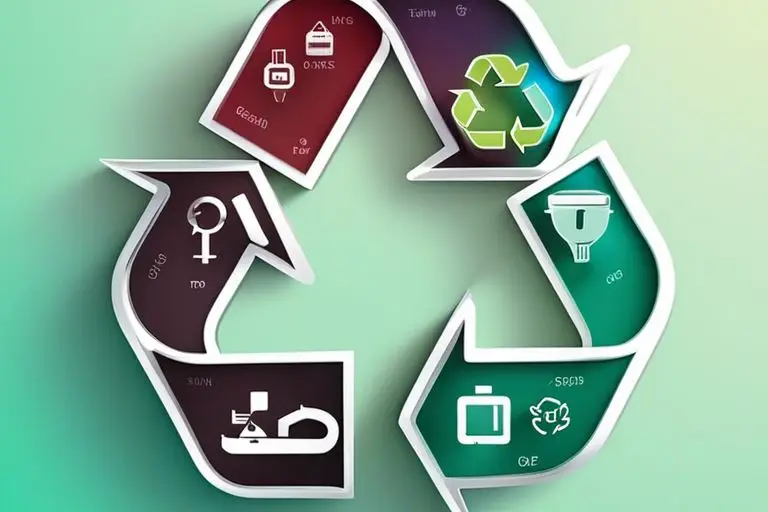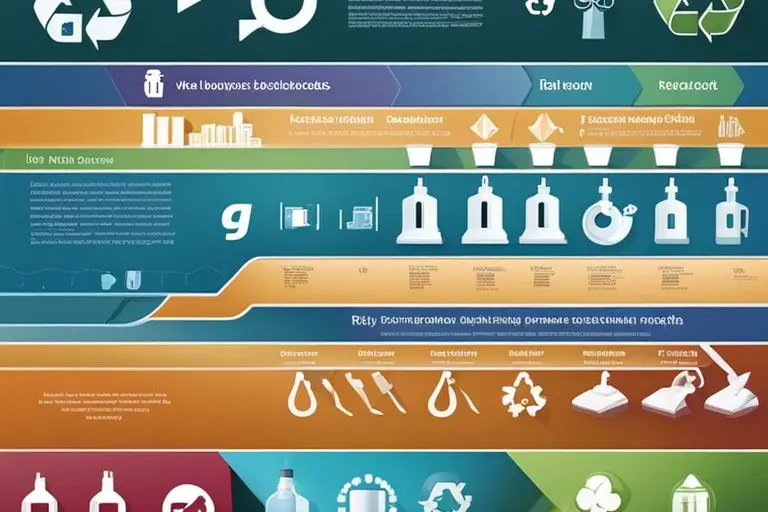There's no denying the importance of proper plastic recycling in today's world. With plastic pollution causing significant harm to our environment and marine life, it's crucial that we all do our part in recycling effectively. Understanding the seven different types of plastic and how to recycle them is a key step towards reducing our impact on the planet. In this post, we will probe into each type of plastic, their characteristics, and the proper recycling methods for each, empowering you to make a positive difference through responsible recycling practices.
Key Takeaways:
- Identify the plastic type: Look for the recycling symbol on the plastic item to determine its type, which is usually represented by a number inside the chasing arrows.
- Separate and clean: Sort the plastics by type and make sure to clean them thoroughly before recycling to avoid contamination.
- Find a recycling center: Locate a local recycling center that accepts the specific types of plastic you have and follow their guidelines for proper recycling.
Recycling Polyethylene Terephthalate (PET or PETE)
Common Uses of PET Plastic
Terephthalate Polyethylene Terephthalate, commonly known as PET or PETE, is widely used in the production of beverage bottles, food containers, and polyester fabrics. Its clear and tough characteristics make it a popular choice for packaging materials, particularly in the food and beverage industry.
The Recycling Process for PET
Polyethylene The recycling process for PET involves several steps. First, the collected PET plastic is sorted and cleaned to remove any impurities. Next, the plastic is shredded into small pieces and then melted to form pellets. These pellets are then used to create new products such as bottles, containers, and even clothing. Recycling PET helps reduce the amount of plastic waste in landfills and conserves natural resources.
Recycling High-Density Polyethylene (HDPE)
Some of the most common types of plastics used in our everyday lives are categorized based on their resin identification codes, known as the recycling numbers 1 through 7. To learn more about these codes, you can visit 1, 2, 3, 4, 5, 6, 7: Plastics Recycling By the Numbers.
Properties and Uses of HDPE
For High-Density Polyethylene (HDPE), this type of plastic is known for its strong and durable nature. It is commonly used in the production of bottles for milk, juice, and detergent, as well as for pipes, plastic lumber, and recycling bins due to its ability to withstand high temperatures and resist chemicals.
Steps to Recycle HDPE Effectively
For recycling HDPE effectively, it is important to first collect HDPE items like bottles and containers. Next, these items need to be sorted from other plastics to ensure purity. Then, the HDPE is cleaned and shredded into small pieces before being melted and molded into new products.
Another crucial step in the recycling process is to ensure that only HDPE items are recycled together as mixing different types of plastics can contaminate the batch and result in low-quality recycled products. By following these steps diligently, we can reduce plastic waste and contribute to a more sustainable future.
Recycling Polyvinyl Chloride (PVC)
Recognizing PVC Products
Not all plastics are created equal, and PVC products can be tricky to identify at first glance. With PVC products, you can usually find the recycling symbol with the number 3 inside it. Additionally, PVC products tend to be rigid and have a glossy appearance. Common items made from PVC include pipes, flooring, credit cards, and even some types of cling film.
How to Recycle PVC Safely
Recognizing the presence of PVC in your plastic items is the first step in proper recycling. Another important thing to note is that PVC should not be mixed with other plastic types during recycling. PVC can release toxic chemicals when burned, so it is crucial to separate it from other plastics. Contact your local recycling center to inquire about their specific PVC recycling policies and ensure safe disposal methods.

Recycling Low-Density Polyethylene (LDPE)
Understanding LDPE Applications
On understanding LDPE applications, it is important to note that LDPE is commonly used in plastic bags, shrink wraps, squeezable bottles, and wire insulation due to its flexible and lightweight nature. LDPE is not suitable for products that require high strength or heat resistance, making it ideal for single-use items.
LDPE Recycling Guidelines
LDPE recycling guidelines are vital to ensure the proper disposal and processing of this type of plastic. When recycling LDPE, it is crucial to clean and dry the items thoroughly before collection. This helps prevent contamination and ensures a higher quality of recycled material.
Understanding LDPE recycling guidelines is crucial in maximizing the sustainability of plastic waste management. Recycling LDPE reduces the amount of plastic waste in landfills and helps conserve valuable resources by turning old plastics into new products.

Recycling Polypropylene (PP)
All 7 Types of Plastic: The Different Materials and Grades serve different purposes, and Polypropylene (PP) is no exception. PP is commonly used in packaging, containers, and automotive parts.
Identifying PP Items
Items made of Polypropylene (PP) are usually marked with the number 5 inside the chasing arrows recycling symbol. Look for this number to identify PP plastics.
The PP Recycling Procedure
To properly recycle Polypropylene (PP), you need to separate it from other plastics during the recycling process. Make sure the PP items are clean and free from any contaminants before recycling them.
It is crucial to note that Polypropylene (PP) is one of the safest plastics to recycle as it has a high melting point, making it suitable for multiple cycles of recycling. However, ensure you follow your local recycling guidelines to maximize the effectiveness of PP recycling.
Recycling Polystyrene (PS)
PS in Daily Use
On a daily basis, we encounter various products made from Polystyrene (PS), such as disposable cups, food containers, packaging materials, and even certain electronics. The lightweight and insulating properties of PS make it a popular choice for these items.
Recycling Challenges and Solutions for PS
Any recycling challenges arise from the fact that PS is not easily accepted by many recycling facilities due to its low density and difficulty to compact. However, there are solutions available to tackle this issue. One solution is to collect and transport PS separately from other recyclables to ensure it reaches the appropriate facility.
To properly recycle PS, it is vital to work with specialized facilities equipped to handle this material. The most important aspect to remember is to never mix PS with other plastics during recycling, as this can contaminate the batch and render it unusable. By segregating PS and ensuring it reaches the right recycling facilities, we can contribute to a more sustainable waste management system.
Recycling Other Plastics (labeled #7 or Other)
Dealing with Less Common Plastics
Keep in mind that plastics labeled #7 or Other are less common and can be a bit trickier to recycle compared to the more widely used plastics. However, it is still important to make an effort to recycle these plastics to reduce waste and environmental impact. Some recycling facilities may accept these plastics, so check with your local recycling program to see if they can be included in your recycling bin.
Innovative Recycling Methods for Mixed or Layered Plastics
With the increasing awareness of the importance of recycling, innovative methods are being developed to tackle the challenge of mixed or layered plastics. The advancement in technology has led to the development of processes that can separate and recycle these complex plastic materials effectively. Companies are investing in state-of-the-art recycling facilities that can handle a variety of plastics, including mixed or layered ones.
Plastics that are mixed or layered pose a significant challenge for traditional recycling methods as they are difficult to separate and recycle efficiently. However, with the development of innovative recycling techniques, such as specialized sorting machinery and chemical processes, it is now possible to effectively recycle these complex plastics. This is crucial in reducing plastic pollution and promoting a more sustainable approach to plastic waste management.
Final Words
To wrap up, properly recycling the 7 different types of plastic is crucial for reducing waste and protecting the environment. By familiarizing yourself with the various plastic codes, rinsing containers before recycling, and separating different types of plastic, you can play a vital role in ensuring that plastic materials are recycled efficiently. Remember to check with your local recycling facilities to understand their specific guidelines and regulations. With some awareness and effort, you can make a significant impact in promoting sustainable practices and reducing the harmful effects of plastic pollution on our planet.
FAQ
Q: What are the 7 different types of plastic?
A: The 7 different types of plastic are identified by the resin identification code (RIC) ranging from number 1 to 7. They include PETE (Polyethylene Terephthalate), HDPE (High-Density Polyethylene), PVC (Polyvinyl Chloride), LDPE (Low-Density Polyethylene), PP (Polypropylene), PS (Polystyrene), and others (often Polycarbonate or ABS).
Q: How can you properly recycle the 7 different types of plastic?
A: To properly recycle the 7 different types of plastic, it is important to first check the bottom of the container for the resin identification code. Then, separate them accordingly into different recycling streams. Ensure the plastics are clean and free of contaminants. Contact your local recycling facility to confirm their recycling capabilities for each type of plastic.
Q: Why is it important to recycle the 7 different types of plastic properly?
A: Properly recycling the 7 different types of plastic is crucial for several reasons. It conserves natural resources, reduces energy consumption, minimizes the amount of plastic waste in landfills and oceans, and helps protect the environment and wildlife. By recycling plastics correctly, we can contribute to a more sustainable future for generations to come.
